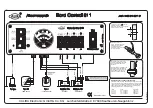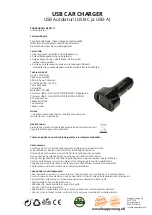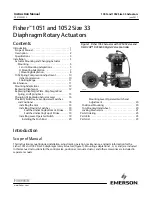
Page 5
Lotus Service Notes
Section KJ
surface, the coolant in the header tank should be close to the 'FULL' mark, represented by the horizontal seam
running around the tank. The lowest acceptable level is 25mm below the seam.
If topping up is required, wait until the engine has fully cooled before slowly unscrewing the filler cap and
allowing any remaining pressure to escape before finally removing the cap.
In order to maintain protection from freezing damage and metal corrosion, use only an approved coolant
mixture (see below) to top up the header tank to the 'FULL' mark. Refit the cap, and turn clockwise until the
tab on the cap engages a detent, at which position an abutment prevents any over-tightening.
NOTICE:
If the cap is removed when the engine is warm, the coolant may boil and a small coolant loss may
occur. The completely cold header tank level should be checked at the first subsequent opportunity.
Anti‑Freeze/Corrosion Inhibitor
It is necessary that the coolant contains an anti-freeze with corrosion inhibitor to protect the engine and
heat exchangers from both frost damage, and corrosion of the metallic elements. In order to protect against
these dangers as well as raising the boiling point of the coolant, the Evora is factory filled with a 50% concentra-
tion of Havoline XLC, which is a mono-ethylene glycol coolant using organic acid technology (OAT) to provide
increased corrosion protection compared with conventional coolant additives. A yellow label around the header
tank neck identifies the coolant type used. The corrosion inhibiting carboxylic acids in the OAT coolant tend to
remain in solution rather than being deposited on the internal surfaces of the cooling system, thus improving
heat transfer and extending service life. Havoline XLC is the only recommended coolant product, and at 50%
concentration provides freezing protection down to approximately - 40°C. Even in warm climates it is recom-
mended that the concentration is not allowed to fall below 25%, in order to maintain full corrosion protection.
The simplest means of checking the antifreeze concentration is to measure the specific gravity (density)
of the coolant at a known temperature, using a hydrometer. The following table provides a general guide:
Density @
Concentration
20°C
60°C
25%
1.039
1.020
33%
1.057
1.034
50%
1.080
1.057
The coolant density reflects the effective level of mono-ethylene glycol, and not the level of corrosion inhibi-
tors present, whose effectiveness diminishes over a period of time. The coolant should therefore be renewed
every 4 years to ensure optimum corrosion protection.
In areas where the tap water is extremely hard (exceeding 250 parts per million), use of this water will
lead to 'furring up' of the system over a period of time. In such areas, distilled, de-ionised or filtered rain water
should be used.
Radiator Fin Cleaning
At service intervals, the matrix of the engine cooling radiator and a.c. condenser should be checked for
clogging by insects, leaves and other debris. If necessary, use a water jet from both above and below to clean
the fins, taking care not to damage the fragile tubes or distort the finning. At the same time, check the integrity
of all cooling system joints, and the condition of all flexible hoses. In snowy conditions, ensure the radiator air
exit is cleared of snow before driving the car.
KJ.3 - DRAIN/REFILL PROCEDURE
Due to the configuration and routing of the cooling system plumbing, there is no satisfactory low point
from which the entire cooling system may easily be self drained. A threaded plug is provided on the radiator
bottom tank, which will drain the radiator, but little more unless the car is tilted nose down to some extent. For
access to the plug, the front undertray must be removed. Each side of the cylinder block is provided with a
drain tap, that on the left being near to the back of the a.c. compressor, and on the right, towards the rear end
of the block.
If the coolant is to be renewed, draining of the pipework can be assisted by applying a low pressure airline
to the header tank filler neck. Note that with ignition off, the heater solenoid shut-off valve is open.
To refill, secure the radiator drain plug, block drain taps and pipework, and fill the system with a recom-
Содержание Evora
Страница 13: ...Page 7 Lotus Service Notes Section AJ ...
Страница 81: ... Lotus Service Notes Section EMR Page 9 EMR 3 COMPONENT LOCATION em239 O2 O2 O2 O2 2009 02 ...
Страница 82: ...Page 10 Lotus Service Notes Section EMR em240 2009 02 ...
Страница 115: ... Lotus Service Notes Section EMR Page 43 2009 02 ...
Страница 116: ...Page 44 Lotus Service Notes Section EMR 2009 02 ...
Страница 118: ...Page 46 Lotus Service Notes Section EMR 2009 02 ...
Страница 184: ...Page 2 Lotus Service Notes Section JL GENERAL LAYOUT TBA ...
Страница 207: ...Page 25 Lotus Service Notes Section JL ...
Страница 233: ...Page 9 Lotus Service Notes Section MR Blank page ...
Страница 259: ...Page 35 Lotus Service Notes Section MR ...
Страница 260: ...Page 36 Lotus Service Notes Section MR ...
Страница 261: ...Page 37 Lotus Service Notes Section MR ...
Страница 262: ...Page 38 Lotus Service Notes Section MR ...
Страница 263: ...Page 39 Lotus Service Notes Section MR ...
Страница 264: ...Page 40 Lotus Service Notes Section MR ...
Страница 265: ...Page 41 Lotus Service Notes Section MR ...
Страница 266: ...Page 42 Lotus Service Notes Section MR ...
Страница 267: ...Page 43 Lotus Service Notes Section MR ...
Страница 268: ...Page 44 Lotus Service Notes Section MR ...
Страница 269: ...Page 45 Lotus Service Notes Section MR ...
Страница 270: ...Page 46 Lotus Service Notes Section MR ...
Страница 271: ...Page 47 Lotus Service Notes Section MR ...
Страница 272: ...Page 48 Lotus Service Notes Section MR ...
Страница 273: ...Page 49 Lotus Service Notes Section MR ...
Страница 274: ...Page 50 Lotus Service Notes Section MR ...
Страница 275: ...Page 51 Lotus Service Notes Section MR ...
Страница 276: ...Page 52 Lotus Service Notes Section MR ...
Страница 277: ...Page 53 Lotus Service Notes Section MR ...
Страница 278: ...Page 54 Lotus Service Notes Section MR ...
Страница 279: ...Page 55 Lotus Service Notes Section MR ...
Страница 280: ...Page 56 Lotus Service Notes Section MR ...
Страница 281: ...Page 57 Lotus Service Notes Section MR ...
Страница 282: ...Page 58 Lotus Service Notes Section MR ...
Страница 283: ...Page 59 Lotus Service Notes Section MR ...
Страница 284: ...Page 60 Lotus Service Notes Section MR ...
Страница 285: ...Page 61 Lotus Service Notes Section MR ...
Страница 286: ...Page 62 Lotus Service Notes Section MR ...
Страница 287: ...Page 63 Lotus Service Notes Section MR ...
Страница 288: ...Page 64 Lotus Service Notes Section MR ...
Страница 289: ...Page 65 Lotus Service Notes Section MR ...
Страница 290: ...Page 66 Lotus Service Notes Section MR ...
Страница 291: ...Page 67 Lotus Service Notes Section MR ...
Страница 292: ...Page 68 Lotus Service Notes Section MR ...
Страница 293: ...Page 69 Lotus Service Notes Section MR ...
Страница 294: ...Page 70 Lotus Service Notes Section MR ...
Страница 295: ...Page 71 Lotus Service Notes Section MR ...
Страница 296: ...Page 72 Lotus Service Notes Section MR ...
Страница 297: ...Page 73 Lotus Service Notes Section MR ...
Страница 298: ...Page 74 Lotus Service Notes Section MR ...
Страница 299: ...Page 75 Lotus Service Notes Section MR ...
Страница 300: ...Page 76 Lotus Service Notes Section MR ...
Страница 301: ...Page 77 Lotus Service Notes Section MR ...
Страница 302: ...Page 78 Lotus Service Notes Section MR ...
Страница 303: ...Page 79 Lotus Service Notes Section MR ...
Страница 304: ...Page 80 Lotus Service Notes Section MR ...
Страница 305: ...Page 81 Lotus Service Notes Section MR ...
Страница 306: ...Page 82 Lotus Service Notes Section MR ...
Страница 307: ...Page 83 Lotus Service Notes Section MR ...
Страница 336: ...Page 2 Lotus Service Notes Section QJ GENERAL LAYOUT Illustration TBA ...
Страница 357: ...Page 2 Lotus Service Notes Section WF Illustration to follow ...
















































